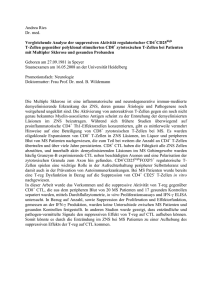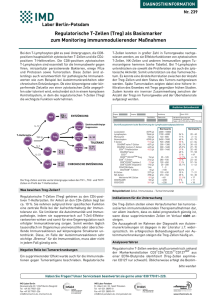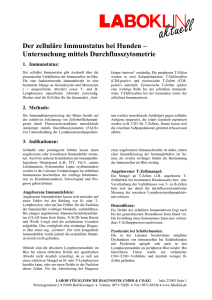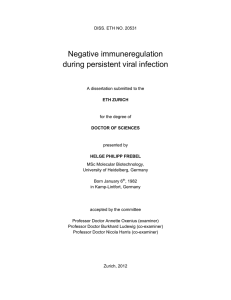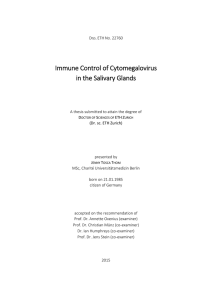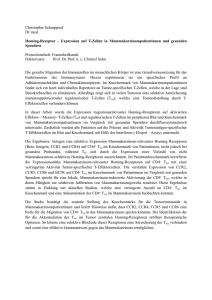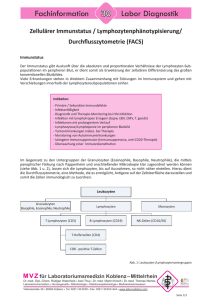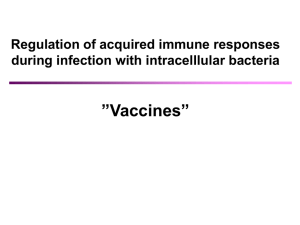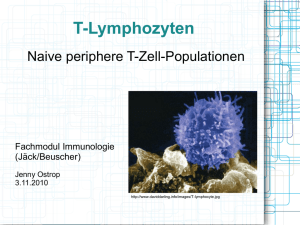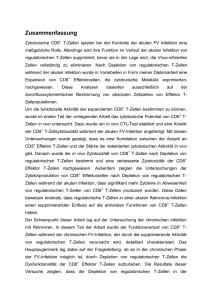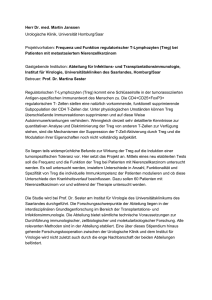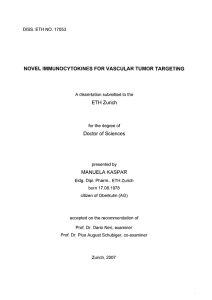Negative regulation of T cell responses in central - ETH E
Werbung
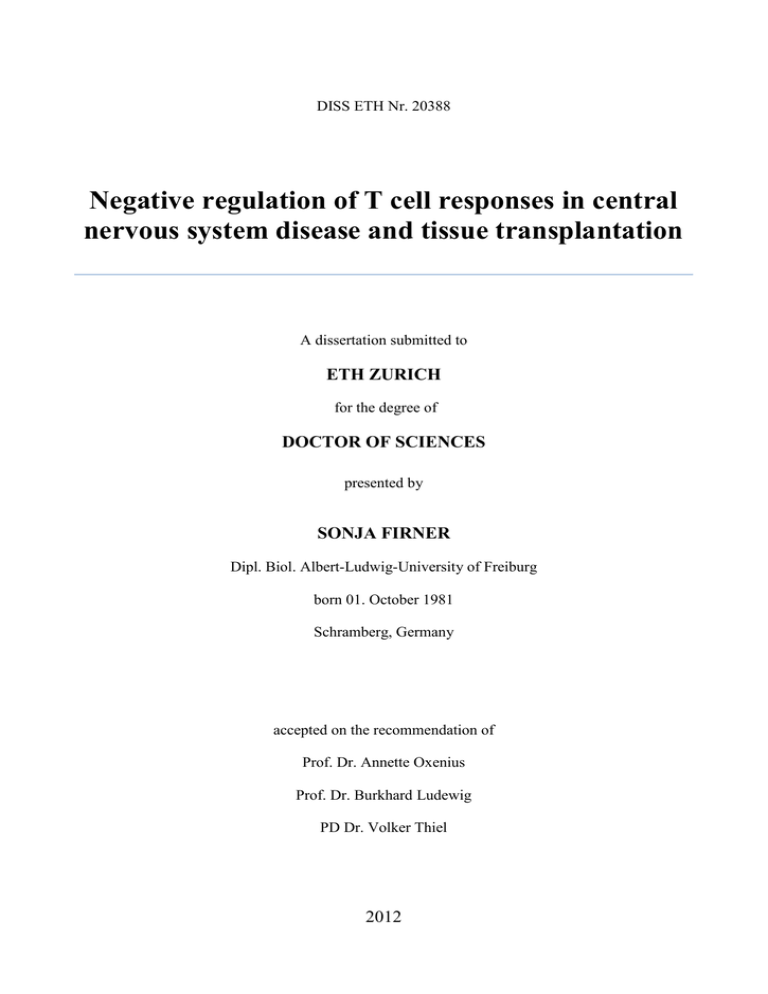
DISS ETH Nr. 20388 Negative regulation of T cell responses in central nervous system disease and tissue transplantation A dissertation submitted to ETH ZURICH for the degree of DOCTOR OF SCIENCES presented by SONJA FIRNER Dipl. Biol. Albert-Ludwig-University of Freiburg born 01. October 1981 Schramberg, Germany accepted on the recommendation of Prof. Dr. Annette Oxenius Prof. Dr. Burkhard Ludewig PD Dr. Volker Thiel 2012 1 SUMMARY Chronic immune response against components of the central nervous system (CNS) is the feature of several neurodegenerative disorders including multiple sclerosis (MS). MS is thought to occur in genetically predisposed individuals following exposure to an environmental trigger including viral infection which leads to activation of self reactive T cells specific for myelin antigens and their access to the CNS (Lucchinetti et al. 2000). It is assumed that the indiscriminate regulation of T cells trough regulatory T cells (Tregs) during viral infection can trigger autoimmune diseases. We analyzed in this study the impact of Treg cells to control effector T cells infiltration to the CNS and virus-induced CNS pathology. Infection of the CNS with the neurotropic mouse hepatitis virus strain A59 (MHV A59) provided an advantageous model in which viral replication is controlled by the immune response but is however unable to achieve the eradication of the virus, resulting in a persisting infection associated with ongoing disease in the absence of infectious virus. To analyze the role of Treg cells in the control the T cell response during a viral infection in the CNS depletion of Treg (DEREG) mice were used. Injection of diphtheria toxin (DT) led to depletion of Treg cells during the course of acute MHV A59 infection. We could show that the viral control was not affected by Tregs. However the lack of Tregs led to an increased CNS-infiltration of virus unrelated cells leading to increased CNS pathology. By transferring myelin specific cells, we were able to show that viral infection is able to induce infiltration of autoreactive T cells to the CNS. Moreover we showed that Treg control the expression of CXCR3 and proliferation of myelin-specific cells within the CNS-draining LN. Taken together, the first part of this thesis revealed a novel mechanism how Treg can contribute to the immune privilege of the CNS, namely by selectively suppressing self reactive T cells while keeping antiviral immunity unaffected. 5 Summary In the second part of this thesis, T cell-intrinsic and –extrinsic regulatory circuits during the interaction of T cells and vascular endothelial cells (ECs) were assessed. This interaction is important because transplantation of organs is the major medical therapy to treat organ failure. However, T cell-mediated immune responses to the grafted tissues represent the major challenge for successful outcome because ECs are severely damaged in the rejection process. Although the application of general immune suppressive drugs results in the avoidance of acute rejection they are unable to prevent chronic rejection. Targeting of mechanisms which induce specific tolerance to grafts could be used to induce lifelong graft tolerance. Therefore, a better understanding of T cell-intrinsic and -extrinsic control mechanisms could help to further improve graft survival. Here, we found that the amount of antigen critically determines the level of tolerance induction to antigen expressed exclusively in ECs. Both adoptively transferred CD4+ and CD8+ T cells were efficiently tolerized when the antigen was expressed systemically on ECs. Furthermore the lack of co-inhibition mediated by programmed cell death (PD-1), B and T lymphocyte attenuator (BTLA) or T regulatory cells (Treg) did not prevent deletion of mHA specific CD8+ T cells, but modulated initial CD4+ T cell activation. Heterotopically transplanted heart grafts expressing the mHA in ECs remained immunologically ignored following transfer of mHA specific CD8+ T cells. However, ablation of the co-inhibitory molecules BTLA or PD-1 resulted in significant CD8+ T cell activation leading to transplant vasculopathy (TV). In contrast, mHA specific CD4+ T cells induced vessel pathology in the presence or absence of negative regulation. These data indicate that activation of CD4+ and CD8+ T cells is differentially regulated by T cell-intrinsic negative regulatory factors. Furthermore, the amount of antigen displayed by ECs critically determines the level of tolerance and the ability negative regulatory factors to modulate peripheral tolerance. 6 2 ZUSAMMENFASSUNG Kennzeichnend für viele neurodegenerative Erkrankungen, unter ihnen die Multiple Sklerose (MS), ist die gegen Bestandteile des Zentralen Nervensystems (ZNS) gerichtete chronische Immunantwort. Obwohl die Krankheitsursache noch nicht vollständig geklärt werden konnte, wird ein Zusammenspiel von genetischen Prädispositionen und Umwelteinflüssen, insbesondere viralen Infektionen, vermutet, welches zum Eindringen aktivierter myelinspezifischer T-Zellen in das ZNS führt. Eine Störung der Regulation der TEffektorzellen durch regulatorische T-Zellen könnte die Ursache dieser Autoimmunerkrankung sein. In dieser Arbeit wurden die Auswirkungen der regulatorischen T-Zell-Kontrolle auf die durch virale Infektion ausgelöste T-Effektorzellinfiltration in das ZNS sowie deren Einfluss auf die Entwicklung der ZNS Pathologie untersucht. Dazu wurden Mäuse mit dem Maus Hepatitis Virus A59, welches sich unter anderem durch Neurotropismus auszeichnet, infiziert. Die darauffolgende Immunantwort kann zwar das Virus dezimieren, es jedoch nicht beseitigen. Der persistierende Virus etabliert eine fortschreitende Demyelinisierung und ist daher geeignet, die Ursachen dieses Prozesses zu untersuchen. Um die Effekte fehlender regulatorischer T-Zellkontrolle im Infektionszeitraum untersuchen zu können, wurden DEREG Mäuse verwendet, bei denen durch Diptheria Toxin Gabe selektiv die regulatorischen T-Zellen eliminiert werden. Überraschenderweise hatte die fehlende Regulation keinen Einfluss auf den Viruskontrollverlauf; es konnte jedoch ein erhöhter Einstrom virusunspezifischer T-Zellen beobachtet werden, welcher mit einem verstärkten pathologischen Bild im ZNS einherging. Durch den Transfer von myelinspezifischen T-Zellen konnte nachgewiesen werden, dass die virale Infektion in der Lage war, autoreaktive T-Zellen ins ZNS zu rekrutieren. 7 Zusammenfassung Des Weiteren konnte gezeigt werden, dass die Regulation der Aktivierung im drainierenden Lymphknoten des ZNS stattfindet. Dort kontrollieren regulatorische T-Zellen den Expressionsgrad des Chemokinrezeptors CXCR3, welcher von T-Zellen für die ZNSInfiltration benötigt wird. Im zweiten Teil dieser Studie wurden die, während der Endothel-T-Zellinteraktion wirkenden zelleigenen und zelläußeren Regelwerke untersucht. Dieser Interaktion wird eine besondere Bedeutung nach Transplantationen beigemessen, da Endothelzellen einen wichtigen Angriffspunkt für alloreaktive T-Zellen darstellen und dadurch maßgeblich zur häufigsten Transplantationskomplikation, der Abstoßungsreaktion, beitragen. Heutige Immunsuppresiva sind zwar in der Lage akute, nicht jedoch chronische Abstoßungsreaktionen zu unterbinden. Deshalb sind T-Zellkontrollmechanismen vielversprechend, die eine organspezifische und dadurch lebenslange Toleranz induzieren können. Um dies zu verwirklichen, ist das Wissen um die von außen und innen wirkenden Kontrollmechanismen von T-Zellen essentiell. Wir konnten zeigen, dass die Menge des T-Zell reaktiven Antigens, welches nur von Endothelzellen exprimiert wurde, über die Toleranzstärke entschied. Die systemische Antigenpräsentation führte zur CD4+- und CD8+-T-Zelltoleranz. Durch Ablation der coinhibierenden Moleküle PD-1 (programmed cell death-1) und BTLA (B and T cell attenuator) sowie durch Eliminierung von regulatorischen T-Zellen wurde die CD4+-, nicht aber die CD8+ T-Zellaktivierung verändert. CD8+-T-Zellen konnten nicht aktiviert werden, wenn die Antigenexpression auf die Endothelzellen von heterotopischen Herztransplantaten beschränkt war. Jedoch führte die Ablation der untersuchten coinhibierenden Moleküle zu CD8+ T-Zellaktivierung, was Gefäßverschlüsse im Transplantat zur Folge hatte. Im Gegensatz dazu war die CD4+T-Zellaktivierung von den untersuchten costimulierenden Molekülen unabhängig. Somit legte diese Untersuchung Unterschiede in der CD4+ und CD8+ T-Zellaktivierung offen, welche über zelleeigene und zelläußere Regulation gesteuert wird. 8 Zusammenfassung Dabei bestimmt die Stärke der Toleranzinduktion, welche über die Menge des Antigens festgelegt wird, ob T-Zellen für diese Änderungen in der Regulationmaschinerie empfänglich sind. 9
